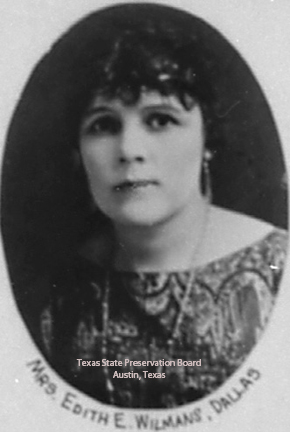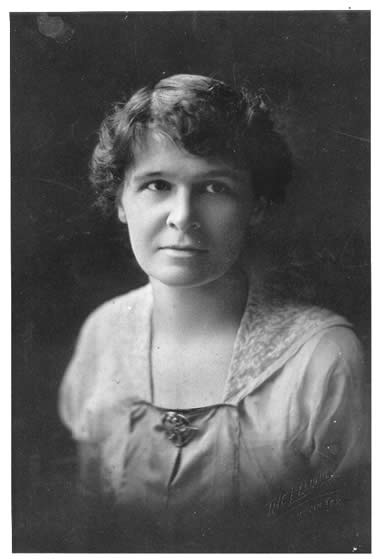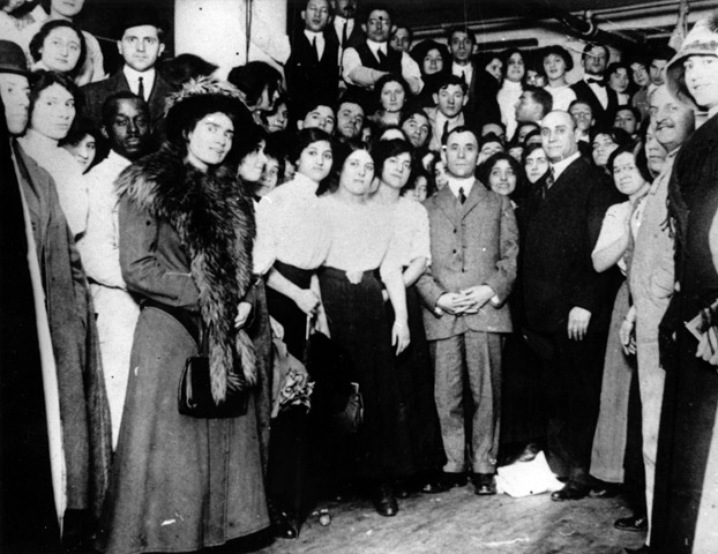 |
|
Rep. Edith Wilmans was the first woman elected to the Texas Legislature. (Photo courtesy of the State Preservation Board) |
 |
|
An online exhibit with the Austin Public Library focuses on the Austin Suffrage Association, headed by Jane McCallum (pictured above). |
 |
|
The owners and workers at the Triangle Shirtwaist Factory, 1910. |
Texas Women: Then and Now
Third in a series of posts about the 33rd Legislature, held 100 years ago. Read the previous posts here and here.
Suffrage
By 1913, woman's suffrage had already been an issue for more than forty years—it was discussed at the state Constitutional Convention of 1868-69. Many Western states, in fact, had already granted women the right to vote. In 1907, Representative Jess Baker had introduced an unsuccessful resolution to give women the vote (HJR 17).
During the 33rd Regular Session of the Texas Legislature, Representative Frank Burmeister introduced HJR 9, giving women the right to vote. While the committee gave it a favorable report, the resolution did not progress any further. The committee minority report states that there was no "popular demand" among women in Texas for the vote, but the very same year, the Texas Woman Suffrage Association was formed (later to become the League of Women Voters of Texas), following the foundation of woman's suffrage clubs in Austin and San Antonio a few years earlier. Five years later, Texas women would gain the right to vote in primaries (1918), and the full right to vote in 1919 with the passage of the Nineteenth Amendment.
"We oppose the effort to reduce the standard of womanhood and we deprecate the effort to dash from the high pedestal upon which Southern manhood has placed them, the wives and daughters of the South and especially of Texas." -Commitee Minority Report
Property Rights and Labor Laws
The legislators of the 33rd Regular Session passed a major milestone for women regarding marital property rights. Houston attorney Hortense S. Ward, one of the first women admitted to the Texas State Bar, worked to help HB 22 by Representative W.B. Goodner become law.
While husbands remained in control of community property, the new law allowed wives to control rent and other income from their own property holdings, as well as income from her stocks and bonds. In addition, wives could now exclusively control their own bank accounts. Previously, a husband could access a bank account held solely in his wife's name. Married women in Texas would not see full property and other rights until 1967; the 1913 law was a major step forward.
Female labor laws were also a concern during this time period. The Triangle Shirtwaist Fire had occurred just two years prior. In 1913, legislators passed SB 30, by Senator O.S. Lattimore, that limited the number of hours females could work. The hours varied by profession (a maximum of 10 or 11 hours in 24 hours and no more than 54 hours per week). The following session, the hours would be further reduced to nine. In 1918, several protections for females in the workplace would be set in place, just as women were entering the workforce because of World War I.
Texas Women in 2013
Since gaining the right to vote in 1919, Texas women have made their voices heard as voters and as legislators and elected officials. Representative Edith Wilmans became the first woman elected to the Texas Legislature in 1923. Today, women make up 21% of the legislature, with 31 representatives and 7 senators. Women serve in our congressional delegation and in high elected office, such as Comptroller Susan Combs. More than 4.5 million Texas women voted in the 2008 presidential election, accounting for 54% of the state electorate.
- How does Texas compare to other states in terms of number of female legislators? Take a look at this map by the National Conference of State Legislators.
- The Governor's Commission for Women was created in 1967 by Gov. John Connally and has been in continuous existence since 1987. Today, the Commission focuses on four specific areas: increasing female participation in the STEM fields (science, technology, engineering and math); assisting women who are older than 50 with workforce skills and job placement; providing assistance to women in military households; and expanding education about women's health issues.
- March is Women’s History Month, a tradition that began in 1909 with National Women’s Day (now International Women’s Day). Learn more about famous Texas women through the Ruthe Winegarten Foundation.
You can learn more about women's issues in Texas and nationwide through resources in the Legislative Reference Library. Books such as "Women and the Texas Revolution," provide historical perspective. Legislative and agency reports going back to the 1970s, such as an interim committee report from 1988 on women and minority-owned businesses, provide context for legislation.
To find current and historic legislation related to women, use the Legislative Archive System and the Texas Legislature Online and peruse the subject list. There are many applicable subjects, such as "Women's Health Program (S0698,)" "Women's Shelters (S0049)," or “Women (I0925).”

